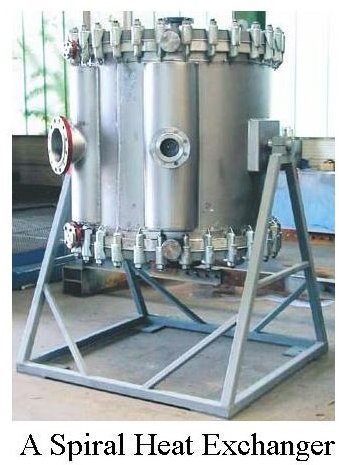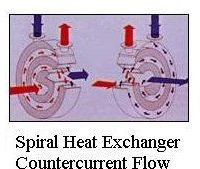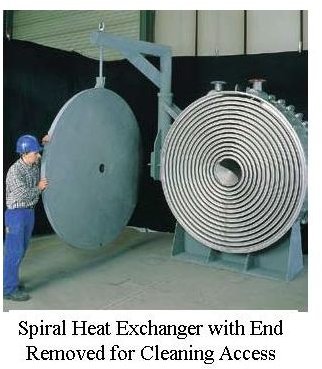The spiral heat exchanger - a higher overall heat transfer coefficient than other types of heat exchangers
Introduction
A spiral heat exchanger is more compact than many other types of heat exchangers. It has two concentric spiral channels, one for the hot fluid and the other for the cold fluid. The main advantages of a spiral heat exchanger are its high overall heat transfer coefficient, compact size for a given heat exchange area, relatively low pressure drop, and ease of cleaning. Spiral heat exchanger flow may be countercurrent flow, cocurrent flow, or crossflow.
General Configuration of a Spiral Heat Exchanger
A spiral heat exchanger is typically cylindrical in overall shape. It is made from two long metal strips that are

wound concentrically around a split center to create two spiral channels, one for the hot fluid and one for the cold fluid. Spacer studs welded to the metal strips before rolling the spiral keep the channel walls spaced apart properly. The end of the heat exchanger cylinder can usually be removed for cleaning of the heat transfer surfaces as shown in the diagram at the left. A picture of a spiral heat exchanger with both ends in place is shown at the right.
Spiral Heat Exchanger Flow Patterns
The flow of the two fluids through a spiral heat exchanger can be countercurrent flow, cocurrent flow, or cross flow. For countercurrent

flow, one fluid will enter at the center of the spiral and exit at the circumference, while the other will enter at the circumference and exit at the center. For cocurrent flow, both fluids will enter at the center and exit at the circumference, or both will enter at the circumference and exit at the center. The fluid flow paths for countercurrent flow through a spiral heat exchanger are illustrated in the figure at the right. For cross flow, one fluid will flow through the spiral path and the other will flow through from one end of the cylinder to the other.
Advantages of Spiral Heat Exchangers
1. A spiral heat exchanger is compact. It has a smaller footprint and less total volume than a shell and tube or plate heat exchanger with the same heat exchange area. The unique spiral roll of long metal strips makes the channels of the same cross-sectional size for both fluids and makes a very compact unit.
2. A spiral heat exchanger is easy to clean. It is, in fact, self-cleaning for many applications because the fluid turbulence created by the spacer studs and curved pathway for the fluids tends to flush away deposits as they form. Good access for cleaning is available when needed by removing one or both of the ends of the heat exchanger, exposing the spiral channels from the side.
3. Spiral heat exchangers have a high overall heat transfer coefficient. Because of the well defined flow path through the spiral channels for both fluids and the fluid turbulence generated by the spacer studs and the curved fluid path, the overall heat transfer coefficient is typically higher for a spiral heat exchanger than for other heat exchanger types.
4. True countercurrent flow is possible with a spiral heat exchanger. Because both fluids are flowing through a channel from one end to the other, it is possible to have flow that is essentially true countercurrent flow. This also contributes to a high heat transfer efficiency and high overall heat transfer coefficient for spiral heat exchangers.
Summary
The spiral heat exchanger is not as widely used as shell and tube or even plate heat exchangers, but it has certain advantages and works well in many applications.
Image Credits
Spiral Heat Exchanger with End Off for Cleaning Access - https://www.tranter.com/europe/spiral-brochure
A Spiral Heat Exchanger Picture - https://www.tranter.com/europe/spiral-brochure
Spiral Heat Exchanger Countercurrent Flow Paths - https://www.goochthermal.com/sphebenefits.html
This post is part of the series: Types of Heat Exchangers
Several types of heat exchangers are used for heating one fluid and cooling another. The types of heat exchangers include the shell and tube heat exchanger, plate heat exchanger, double pipe heat exchanger, and spiral heat exchanger. Most of these heat exchangers can be counterflow or parallel flow.
